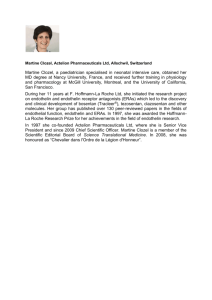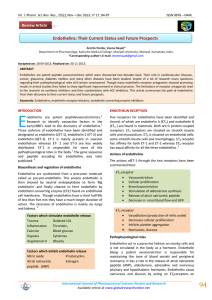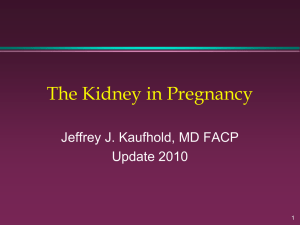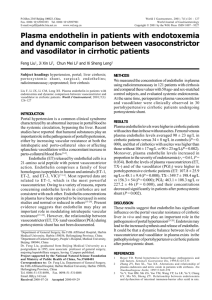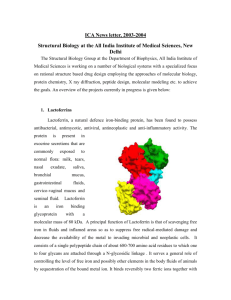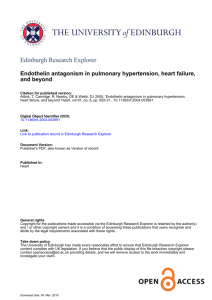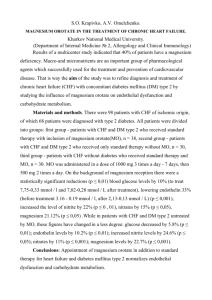Still beyond reach
advertisement
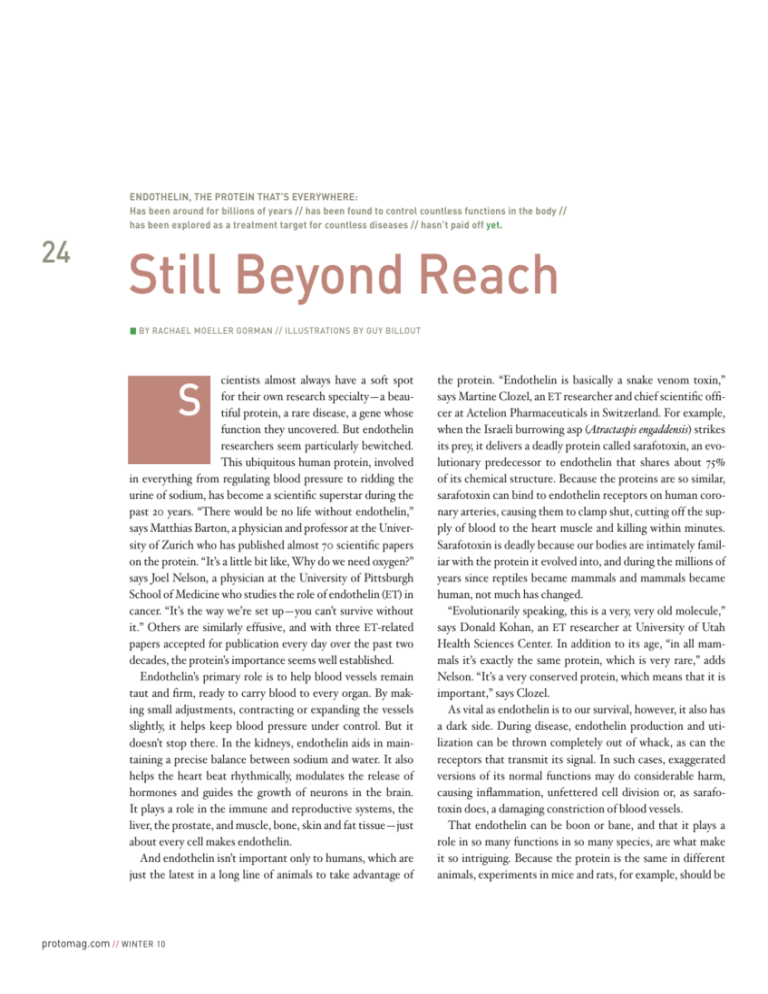
Endothelin, the protein that’s everywhere: Has been around for billions of years // has been found to control countless functions in the body // has been explored as a treatment target for countless diseases // hasn’t paid off yet. 24 Still Beyond Reach by rachael moeller gorman // Illustrations by guy billout S cientists almost always have a soft spot for their own research specialty—a beautiful protein, a rare disease, a gene whose function they uncovered. But endothelin researchers seem particularly bewitched. This ubiquitous human protein, involved in everything from regulating blood pressure to ridding the urine of sodium, has become a scientific superstar during the past 20 years. “There would be no life without endothelin,” says Matthias Barton, a physician and professor at the University of Zurich who has published almost 70 scientific papers on the protein. “It’s a little bit like, Why do we need oxygen?” says Joel Nelson, a physician at the University of Pittsburgh School of Medicine who studies the role of endothelin (ET) in cancer. “It’s the way we’re set up—you can’t survive without it.” Others are similarly effusive, and with three ET-related papers accepted for publication every day over the past two decades, the protein’s importance seems well established. Endothelin’s primary role is to help blood vessels remain taut and firm, ready to carry blood to every organ. By making small adjustments, contracting or expanding the vessels slightly, it helps keep blood pressure under control. But it doesn’t stop there. In the kidneys, endothelin aids in maintaining a precise balance between sodium and water. It also helps the heart beat rhythmically, modulates the release of hormones and guides the growth of neurons in the brain. It plays a role in the immune and reproductive systems, the liver, the prostate, and muscle, bone, skin and fat tissue—just about every cell makes endothelin. And endothelin isn’t important only to humans, which are just the latest in a long line of animals to take advantage of protomag.com // Winter 10 the protein. “Endothelin is basically a snake venom toxin,” says Martine Clozel, an ET researcher and chief scientific officer at Actelion Pharmaceuticals in Switzerland. For example, when the Israeli burrowing asp (Atractaspis engaddensis) strikes its prey, it delivers a deadly protein called sarafotoxin, an evolutionary predecessor to endothelin that shares about 75% of its chemical structure. Because the proteins are so similar, sarafotoxin can bind to endothelin receptors on human coronary arteries, causing them to clamp shut, cutting off the supply of blood to the heart muscle and killing within minutes. Sarafotoxin is deadly because our bodies are intimately familiar with the protein it evolved into, and during the millions of years since reptiles became mammals and mammals became human, not much has changed. “Evolutionarily speaking, this is a very, very old molecule,” says Donald Kohan, an ET researcher at University of Utah Health Sciences Center. In addition to its age, “in all mammals it’s exactly the same protein, which is very rare,” adds Nelson. “It’s a very conserved protein, which means that it is important,” says Clozel. As vital as endothelin is to our survival, however, it also has a dark side. During disease, endothelin production and utilization can be thrown completely out of whack, as can the receptors that transmit its signal. In such cases, exaggerated versions of its normal functions may do considerable harm, causing inflammation, unfettered cell division or, as sarafotoxin does, a damaging constriction of blood vessels. That endothelin can be boon or bane, and that it plays a role in so many functions in so many species, are what make it so intriguing. Because the protein is the same in different animals, experiments in mice and rats, for example, should be 26 particularly useful in predicting how a disease may progress in humans—or how a new drug might arrest its development. But even more important is that one or a few therapies could have widespread effects in regulating endothelin and therefore treating the many diseases in which it is involved. That’s why, after endothelin was discovered in 1988, in the blood vessels of pigs, scientists became giddy with excitement about all they might do with the protein. Drugs to block ET could be used to lower blood pressure, to treat chronic kidney disease and perhaps even to cure cancer—or so they thought. Yet after more than 20 years of research, few of those ideas have come to fruition. Only two rare diseases have approved treatments resulting from ET research, and those therapies can have serious side effects. But the work continues, and with more than 25 clinical trials currently under way, the once-ebullient endothelin researchers are cautiously hopeful that their favorite protein will yet live up to their ambitious dreams. E ndothelin took its name from the place the protein was discovered—in the endothelium of blood vessels— though it might just as easily have been found almost anywhere in the body. The endothelium is a single layer of cells that lines the walls of blood vessels, and scientists had long believed those cells just provided passive physical protection to the vessels. But in 1980, Robert Furchgott, a scientist at the State University of New York’s Downstate Medical Center in Brooklyn, noticed that endothelial cells release a substance that causes blood vessels to widen, thus reducing the pressure inside them. In 1987 that substance was identified as nitric oxide, protomag.com // Winter 10 and Furchgott shared the 1998 Nobel Prize in Physiology or Medicine for his discovery and subsequent work on the gas. Meanwhile, in 1985 Robert Highsmith and his colleagues at the University of Cincinnati College of Medicine found that endothelial cells also release another substance, one that appeared to counterbalance the dilation caused by nitric oxide. Highsmith placed endothelial cells in a liquid medium and applied the medium to a specimen of pig coronary artery. The cells contracted. It took three years for researchers to identify the protein triggering this constriction. In Tsukuba, Japan, graduate student Masashi Yanagisawa came across Highsmith’s paper about his team’s work and proposed, for his doctoral thesis, to identify the mystery substance. His supervisor, Tomoh Masaki, and several other researchers joined the quest, and in March 1988, in the journal Nature, Yanagisawa published a paper that launched an entire field of research. The paper described the protein—a 21-amino-acid peptide—and the DNA sequence that encodes it, and named it endothelin. The team’s experiments had established that endothelin was by far the most powerful vasoconstrictor ever encountered, 10 times as potent as the previous record holder, a protein called angiotensin II. Researchers next figured out where the endothelin goes after being released by endothelial cells: It binds to ET receptors on the membranes of the blood vessel’s smooth muscle cells, clearing the way for calcium to be released into them, which causes them to contract, shrinking the diameter of the vessel. That effect is counterbalanced by other factors (including, in some cases, ET itself) that help the vessel dilate. This tension between shrinking and expanding maintains vascular tone, keeping blood vessels from collapsing in on themselves. Soon, however, researchers discovered that endothelin does much more than regulate blood pressure. Its fingerprints are everywhere, and its role has been documented in more than 22,000 published papers. It also turns out that there are three versions, ET-1, ET-2 and ET-3, that bind to two kinds of endothelin receptors, ETA and ETB. This growing understanding of endothelin and its receptors led to a search for substances that might regulate the effects of excessive amounts of the protein. Drug companies began scanning their libraries of chemical compounds for likely candidates, and an initial success came in 1993, with the production of the first endothelin receptor antagonist. It and subsequently developed ET blockers close off receptors, preventing endothelin from beginning the chemical processes that would normally ensue. The first human clinical trial of endothelin receptor antagonists began in the early 1990s, and the target was a big one: congestive heart failure, which affects as many as 5 million people in the United States. Studies had shown that patients who had suffered heart attacks had above-normal levels of ET-1 and that their chance of survival after an attack dropped when ET-1 levels remained high. Moreover, in 1999 researchers found that in animals that had had heart attacks, blocking ET-1 improved survival rates and aided in the repair of damaged heart muscle. All these findings led researchers to expect great things from trials of receptor antagonists in people with congestive heart failure. Yet the results fell far short of the hopes. Large, long-term, randomized clinical trials tested four types of endothelin receptor antagonists, and none proved effective. For more on why some endothelin trials didn’t work—and why some future trials might, go to protomag.com/endothelin. People who took endothelin blockers along with standard heart failure drugs fared no better than those who didn’t get them, and in at least one trial, taking the blockers was actually linked to worse results. Side effects, including liver problems, also caused trouble, and one trial had to be stopped early. These failures could have been related to the trials’ designs. Because the endothelin blockers were given in addition to standard heart failure therapy, it’s possible that their effect was masked by the other drugs. Also, some patients may have had existing edema or other conditions that complicated trial results, and it’s possible that the drug dosages used weren’t optimal. Or it could be that the drugs were rushed into human trials too soon. Endothelin had been discovered only seven years before the first trial, and its role in the body was 27 Endothelin’s fingerprints are everywhere, and its role has been documented in more than 22,000 published papers. just beginning to be understood. Even the animal studies on endothelin blockers for congestive heart failure were suspect, having largely been done on previously healthy animals whose heart attacks had been experimentally induced. Most humans who have attacks, in contrast, have previous heart damage and coronary artery disease. “Never before had a cardiovascular drug been used so quickly in a clinical trial, before we really understood the system it was targeting,” says Barton of the University of Zurich. But whatever went wrong, the trials’ failures probably closed the door on using ET blockers to treat congestive heart failure—and put a hole in the idea that regulating endothelin, part of so many human systems, might provide a quick path to therapies for a range of diseases. A bout the same time that scientists began publishing the disappointing results of trials on congestive heart failure, Clozel of Actelion Pharmaceuticals started testing an endothelin receptor antagonist, bosentan, in Winter 10 // protomag.com 28 animal models of a rare lung disease called pulmonary arterial hypertension, or PAH. Early research suggested that endothelin might play a role in PAH, which kills about 16,000 people every year in the United States. (In PAH, the walls of the small vessels throughout the lungs thicken and stiffen, raising blood pressure and increasing pressure in the pulmonary artery supplying those capillaries. This overworks the heart’s right ventricle, causing lethal damage. Although PAH can be caused by a genetic defect, many cases arise from unknown origins.) Studies had shown that ET-1 levels are elevated in the blood and in the lung tissue of people with PAH, and that higher ET-1 levels corresponded to a reduced chance of survival. Clozel wanted to see whether endothelin receptor antagonists could slow or stop the disease. Her studies in rats and pigs showed that blocking the receptors with bosentan made the pulmonary hypertension less severe, and tests in humans demonstrated that keeping endothelin from connecting with ET receptors could prevent, attenuate or even reverse changes in the blood vessels that make it harder for blood to flow through the lungs and lead to suffocation of the heart muscle. In a series of double-blind, placebo-controlled trials, bosentan improved blood flow in the lungs and increased exercise capacity while slowing the progress of the disease. Longer-term studies found lasting benefits, and patients who take bosentan live longer. In 2001 the U.S. Food and Drug Administration approved bosentan (Tracleer) for treating PAH, and in 2007 it okayed another ET receptor antagonist, ambrisentan (Letairis). A third ET receptor antagonist, sitaxentan, is approved in the European Union, Canada and Australia. In addition, in 2007 bosentan was approved in the European Union for prevention of digital ulcerations (open sores on the fingertips). A lthough bosentan and other endothelin blockers have proved to be enormously beneficial to people with PAH, many authors of those 22,000 endothelin papers had something far grander in mind. Yet almost every attempt at treating widely protomag.com // Winter 10 prevalent ET-related disorders has suffered the same fate as the early trials for congestive heart failure. Consider prostate cancer. In the mid-1990s, researchers found that the cancers known as adenocarcinomas, which include prostate tumors, produce quite a lot of ET. Of course, the same can be said of many cells throughout the body, but ET appears to do many things that are hallmarks of cancer. It encourages cell proliferation, helps new blood vessels supply tumors so the tumors can thrive, and prevents cells from dying on schedule. Endothelin also seems to play some yetunknown role in cancer pain. To explore whether ET blockers might have a positive effect in cancer cases, Pittsburgh’s Nelson and his colleagues tested the safety of various doses of the ET receptor antagonist atrasentan in cancer patients in 2002, then the following Many endothelin researchers seem to think the holy grail remains just out of reach, and some are continuing their quest but taking a different tack. year completed a placebo-controlled trial of 288 patients. The results were promising, with a slowing of the progression of the disease. Yet larger trials involving patients with metastatic and nonmetastatic prostate cancer found marginal improvements at best. And once again, side effects, including nasal congestion, headaches, edema and heart failure, were an issue. Indeed, the unintended effects of endothelin blockers have been one reason that more of them haven’t made it to market. Nonetheless, many endothelin researchers seem to think the holy grail remains just out of reach, and some are continuing their quest but taking a different tack. Even if ET receptor antagonists can’t cure all the major diseases known to man, perhaps they can help in smaller, subtler ways. Three stillexperimental uses of ET blockers might succeed in treating subpopulations of patients with relatively common conditions for which there are no other effective therapies. The first involves diabetics with chronic kidney disease. The surge in the prevalence of type 2 diabetes has brought with it rising numbers of kidney cases, with some 30% to 40% of diabetics developing a condition called nephropathy. According to the National Diabetes Information Clearinghouse, almost a quarter of the U.S. population age 60 and older has diabetes, so that amounts to millions of people with kidney disease. And normally effective treatments, ACE inhibitors and angiotensin II antagonists, don’t work well in people with diabetes. In diabetic rats, however, an ET receptor antagonist has had several positive effects. It reduced high blood pressure, cut levels of protein in the urine and improved renal blood flow—all signs of better-functioning kidneys. When the rats also received an ACE inhibitor called lisinopril, their kidneys fared even better, reverting almost to normal. And in a recent trial involving 286 people with diabetic kidney disease, an ETA receptor antagonist called avosentan and an ACE inhibitor reduced the amount of protein in the urine, a promising development. Resistant hypertension is another area in which ET receptor antagonists might play a role. There are many normally effective drugs for reducing blood pressure, and in most cases just one or two of them will get the job done. But for as many as 25 million Americans, taking even three or more drugs doesn’t work. In 1998, Barton found that an ET receptor antagonist reduced blood pressure in rats with resistant hypertension and even appeared to repair some of the damage to arteries that high blood pressure had caused. In a recent trial involving 379 people whose hypertension had not been brought under control by taking three or more of the usual drugs, taking an ET blocker resulted in significant improvement. Finally, even prostate cancer patients may benefit from attempts to control excessive production of endothelin. In the lab, the combination of the chemotherapy drug paclitaxel (Taxol) and atrasentan decreased prostate tumor growth significantly more than either agent achieved on its own. Endothelin can stop cells from dying, thus helping tumors grow, and blocking it with an ET receptor antagonist may permit chemotherapy drugs to do their job. Clinical trials are currently testing this idea in people. After years of meticulous work in the lab and on animals, the failure of so many human endothelin trials has been disappointing. And the work in these three latest areas, though promising, may also fail if and when larger human trials are completed. Yet as researchers come to better understand the subtle role this protein plays in various body systems and diseases, scientists seem likely to continue to search for effective therapies, even if the populations that benefit are measured in mere thousands, rather than tens of millions. 29 Dossier 1. “A Novel Potent Vasoconstrictor Peptide Produced by Vascular Endothelial Cells,” by Masashi Yanagisawa et al., Nature, March 1988. In the paper that launched the field of endothelin research, Yanagisawa describes his discovery of the most powerful vasoconstrictor ever found. 2. “Pathophysiological Role of Endothelin Revealed by the First Orally Active Endothelin Receptor Antagonist,” by Martine Clozel et al., Nature, October 1993. Researchers describe the precursor to bosentan, the first endothelin-targeting compound to be used in humans, to treat pulmonary arterial hypertension. 3. “Endothelin: 20 Years From Discovery to Therapy,” by Matthias Barton and Masashi Yanagisawa, Canadian Journal of Physiology and Pharmacology, July 2008. The comprehensive review describes this burgeoning field of research, beginning with endothelin’s discovery as a simple vasoconstrictor. Winter 10 // protomag.com
